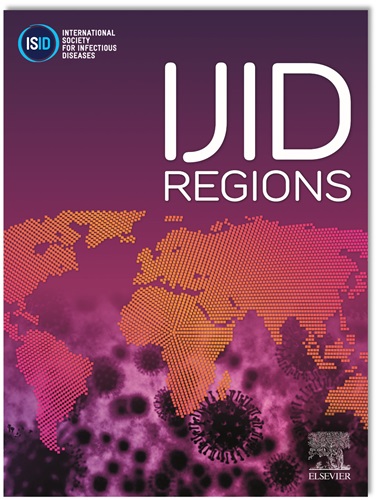Pseudomonas aeruginosa community-acquired pneumonia following soil ingestion: A case report
IF 4.8
2区 医学
Q1 INFECTIOUS DISEASES
引用次数: 0
Abstract
Background
Pseudomonas aeruginosa (P. aeruginosa) is an uncommon etiological agent in community-acquired pneumonia (CAP), typically associated with nosocomial or healthcare-associated infections, particularly in patients with underlying structural lung abnormalities or immunosuppression. P. aeruginosa is a ubiquitous gram-negative rod, widely distributed in the environment. However, CAP due to P. aeruginosa following soil ingestion is exceedingly rare.
Case presentation
We present the case of a previously healthy 31-year-old patient, a middle school teacher, who developed CAP due to P. aeruginosa after ingesting garden soil for three consecutive days. The patient was admitted with symptoms including fever, chest pain, vomiting, and diarrhea. Chest computed tomography (CT) revealed two suspicious lesions in the left lower lobe, with one lesion exhibiting cavitation. Microbiological culture of bronchoalveolar lavage fluid (BALF) and stool confirmed the presence of P. aeruginosa infection. Subsequent antimicrobial susceptibility testing revealed that the P. aeruginosa isolate was pan-sensitive. Following 13 days of targeted antimicrobial therapy, the patient's symptoms and laboratory markers of infection improved significantly. A follow-up CT scan one month later demonstrated substantial resolution of the left lower lobe lesions, and the patient remained asymptomatic.
Conclusions
This case, along with a review of related literature, suggests that geophagy may be a potential risk factor for P. aeruginosa infection. It underscores the importance of avoiding the consumption of unprocessed soil, which may be contaminated with pathogenic organisms.
土壤摄食后铜绿假单胞菌社区获得性肺炎1例报告。
背景:铜绿假单胞菌(P. aeruginosa)是社区获得性肺炎(CAP)中一种罕见的病原体,通常与医院或医疗保健相关感染有关,特别是在潜在的结构性肺异常或免疫抑制患者中。铜绿假单胞菌是一种普遍存在的革兰氏阴性杆状菌,广泛分布于环境中。然而,由于土壤摄食铜绿假单胞菌的CAP是非常罕见的。病例报告:我们报告了一位31岁的健康患者,一位中学教师,在连续三天摄入花园土壤后,由于铜绿假单胞菌而发展为CAP。患者入院时出现发热、胸痛、呕吐和腹泻等症状。胸部计算机断层扫描(CT)显示左下叶两个可疑病变,其中一个病变表现为空化。支气管肺泡灌洗液(BALF)和粪便微生物培养证实铜绿假单胞菌感染。随后的药敏试验表明,铜绿假单胞菌分离物具有泛敏感性。经过13天的靶向抗菌药物治疗,患者的症状和感染的实验室指标明显改善。一个月后的随访CT扫描显示左下叶病变明显消退,患者仍无症状。结论:本病例及相关文献提示食土可能是铜绿假单胞菌感染的潜在危险因素。它强调了避免食用未经处理的土壤的重要性,因为这些土壤可能被病原生物污染。
本文章由计算机程序翻译,如有差异,请以英文原文为准。
求助全文
约1分钟内获得全文
求助全文
来源期刊
CiteScore
18.90
自引率
2.40%
发文量
1020
审稿时长
30 days
期刊介绍:
International Journal of Infectious Diseases (IJID)
Publisher: International Society for Infectious Diseases
Publication Frequency: Monthly
Type: Peer-reviewed, Open Access
Scope:
Publishes original clinical and laboratory-based research.
Reports clinical trials, reviews, and some case reports.
Focuses on epidemiology, clinical diagnosis, treatment, and control of infectious diseases.
Emphasizes diseases common in under-resourced countries.

 求助内容:
求助内容: 应助结果提醒方式:
应助结果提醒方式:


